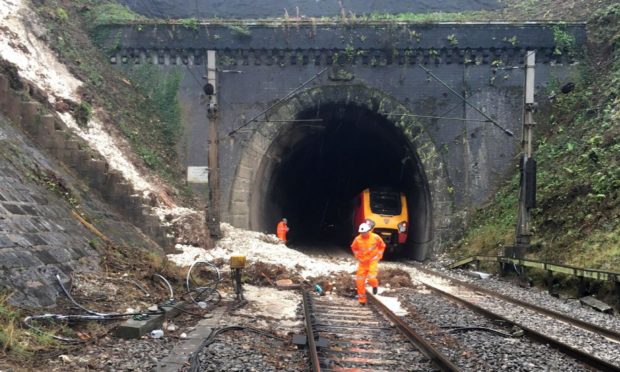Soil, dirt, earth, turf; whatever you call it, the ground beneath our feet isn’t particularly interesting to the average person. Until it is piled up in front of a train travelling at speed, that is.
But how does that soil get there?
Here, we speak to experts who explain exactly that, and examine why the biblical summer rains that fell in the run-up to the Stonehaven train’s derailment are set to become a common occurrence.
What is a landslip and how can it derail a train?
A landslip is defined as the movement of soil and rocks down a slope.
Also known as landslides, these phenomena can occur anywhere, sometimes moving very slowly over several days and other times tumbling down steep slopes in a matter of seconds.
Although fairly common, the impact of landslips on railways and other infrastructure can, on rare occasions, lead to tragedy and disruption. After all, a train can’t swerve to avoid debris on the line in the same way a car can avoid an obstruction on the road.
Landslips happen when the ground becomes so saturated with water that the soil becomes loose and unstable. Once the earth is in this state, it becomes extremely unpredictable.
“Different types of soil react differently to deluges of water,” said soil physicist Dr Ken Loades, who works at the James Hutton Institute in Dundee.
“Sandy soil absorbs water very quickly for example, while clay soils are much more solid and take a long time to absorb flood water – though they do hold water better and allow crops to grow better during droughts.
“Up in the Highlands you’d get more peaty soils, but around the north-east coast and in places like Stonehaven you’d expect to see mostly mineral sandy soils which are pretty porous and free-draining.
“What’s interesting is that soils can be very diverse in a small area, so you can get differences within the same field for example, and particularly if an area is on a slope.”
The landslip at Carmont occurred after a wetter than average summer for Scotland.
The soil was already moist when the thunderstorm hit, limiting its ability to absorb all the sudden rain which came tumbling down.
It didn’t take long to become entirely waterlogged, and the risk of a landslip began to rise.
“There are typically three types of landslip which can occur,” said Ken. “If you imagine a slice of millionaires shortbread in your mind, with the layers of shortbread, caramel and chocolate, that is a good place to start.”
He explains that the first type of landslip is where the top layer of soil (or chocolate) becomes so loose that it simply slides off the remaining layers. The second type is known as a rotational failure, and involves soil at the bottom of a slope (the shortbread) rotating in a semi-circular way leaving the ground unstable. The third type is a flow of every material, which typically involves a gully where water can concentrate before eventually causing a total failure in the structure of the hill and a flow of rocks, boulders, soil and other debris tumble down on to the land below.
Sometimes it is just a 20cm layer of slowly moving dirt. Other times it is a dirty great river three meters deep gliding over the surface with enough energy to bring down huge boulders. It is not yet known which type of landslip occurred at Carmont.
“It is important to note that landslips can happen on any type of soil,” Ken said. “The critical parameter is that the water builds up in the soil quicker than it can drain away, and that’s when you end up with a landslip occurring.”
When water is added into the mix
Another key factor is weight. Ken explains that when dry, one cubic meter of soil weighs about 1.3 tons. But add water into the mix and the equation changes.
“What usually weighs just over a ton, suddenly weighs two,” he said. “And there is a lot of mass in there too to contend with.”
So not only is soil unstable after being forced apart by prolonged heavy rain, it is also double the weight it usually is, creating yet more instability.
And once you’ve had one landslip in a certain area, chances are history will repeat itself.
“Landslips are dynamic,” said Ken. “Soil creep happens over long periods of time for example, and so can things like tension cracks.
“Soil is often under great stress and there is always potential for failure after and during heavy rainfall. Landslips do tend to happen in the same areas repeatedly for this reason.”
The above data from the British Geological Survey (BGS) shows that the frequency of landslips appears to have exploded in recent decades. Although this points to climate change and increased rainfall, there are other factors to consider.
Better recording and detection of landslips is one of the key reasons for the increase, another is that the BGS did not used to record events which happened on engineered slopes – such as those on railways.
Analysis carried out by the Met Office shows that the UK is experiencing more extreme rainfall events than ever and that this is likely linked to climate change.
Scotland experienced several months of above-average rainfall from April to December 2012, making it one of the wettest periods of time for most of the country since meteorological records began.
Throughout this period, and into early 2013, a marked increase in the number of landslides was recorded. Further well-publicised storm events in the winter of 2015 caused another peak in the landslide graph.
The experts say that these “peaks” are only going to become more commonplace, but Ken is keen to point out that all is not lost.
“There is not one approach that will work for everywhere and it all very much depends on the risk at that particular site,” he said.
“But we can increase drainage, manage vegetation, build walls… defences do work, and using the right approach in the right location is absolutely key.”
Are we going to see more landslips?
From the bushfires setting Australia alight to the tropical storms sending parts of the US underwater, climate change can feel like a far-off problem when you live in the north of Scotland.
Here there are no hurricanes, no golf ball-sized hailstones and barely a hosepipe ban in living memory.
But when a train derailed just outside Stonehaven on August 12 suddenly this distant threat was brought much closer to home.
Three people died when the train hit a landslip on the tracks, caused by the extreme weather earlier that morning.
An intense summer storm had dumped a month’s worth of rain on the region in under four hours, washing soil, rocks and gravel out into the line of the oncoming train.
Flooding like this is not unheard of in the area, and Carmont, where the train crashed, has seen its share of disruptions in the past thanks to inclement weather.
But this was more than just inclement. According to experts, it was downright extreme.
“We are seeing more and more of what are considered to be ‘extreme’ weather events,” said Dr Mike Rivington, a climate change expert based in the north-east’s James Hutton Institute.
“The UK Met Office have long put out the headline message that climate change means wetter winters and hotter summers for the UK, but there are huge amounts of variability within that and the extremes are becoming increasingly common.
“The droughts are longer and the floods more intense, and the frequency of these events is only set to increase.”
‘Randomness’ of rainfall events to increase
Rising average temperatures pose a problem as warm air holds more moisture than cooler air, increasing the risk of tropical-like downpours during summer months.
“There is also significant scientific evidence that raindrops are getting bigger and hence have more kinetic energy,” said Mike. So not only is the air able to hold more rain, but the drops it is holding are bigger and heavier than ever.
It is not just the intensity of these rainfall events which is set to increase, but the randomness too.
“A particular rain cloud may pass over your house and drop large quantities of rain but miss your friend’s two miles down the road,” Mike said.
“Your garden might be flooded while they are basking in sun. We are becoming quite familiar with this sort of localised event where a huge amount of rain falls within a very short period creating flash-flood type conditions.”
Residents of the north-east will remember the exceptionally wet and wild conditions they woke to on the morning of August 12.
Submerged cars bobbed down Holburn Street while many schools were closed and residents evacuated.
Yet by mid-afternoon the bulk of the water had disappeared as mysteriously as it had come, leaving in its wake both a trail of destruction and a beautifully warm summer day.
“It’s well recognised that infrastructure will be under more pressure in the future because of what would normally be called ‘natural events’ like this,” said Mike. “They are still natural events of course, but the intensity and severity are likely to increase [due to climate change].”
He notes that there has already been a significant level of investment put in place by councils and private organisations to combat the effects of our increasingly extreme weather, though does make the point that some are better prepared than others.
Transport is a particularly contentious issue, and with the fatal derailment at Stonehaven still fresh in our minds, trains are taking centre stage.
‘It’s very hard to predict what ‘severe’ rainfall might look like in 10 or 20 years.’
The UK has the oldest running railway system in the world. Much of the infrastructure and earthworks are more than 150 years old, constructed by navvies using whatever material was to hand.
With well over 20,000 miles of train tracks covering the length and breadth of the UK, updating every inch with cutting edge technology capable of withstanding increasingly extreme weather is no simple task.
As it stands, Network Rail is currently working its way through a climate change adaptation programme designed to create “a railway that is safe and more resilient to the effects of weather, now and in the future”.
But it is a slow and expensive business. And, as Mike says, the goalposts are constantly moving.
“It’s difficult to plan when you don’t know really what you’re planning for,” he said. “Looking ahead to the future, the level of adaptations being put in place now may not be enough for these new extreme events.
“It’s very hard to predict what ‘severe’ rainfall might look like in 10 or 20 years. For example, how high should flood defences be? It’s easy enough to build them 20 meters tall if you have to, but all it takes is that extra half meter of floodwater for them to fail.”
While landslips are only one consequence of changing weather patterns, Mike is grimly confident they are a phenomenon we are going to be seeing a lot more of in future.
It is all down to the threshold at which landslides occur, Mike says. “And it’s reasonable to assume that we will be crossing that threshold more often.
It is quite simple, soil on a slope can only tolerate a certain amount of rain.
“A cubic meter of soil might weigh 1.3 tonnes when it’s reasonably dry but after heavy rainfall this might swell to two tonnes, which might push it over the threshold of say 1.9 tons at which the slope is stable.
“If we have conditions where soils are already saturated and close to that threshold, it becomes much more likely that high-intensity rainfall events – as are suggested by climate change predictions – will create more of these types of incidents.”


















